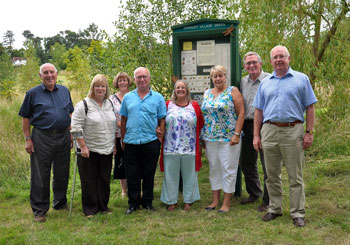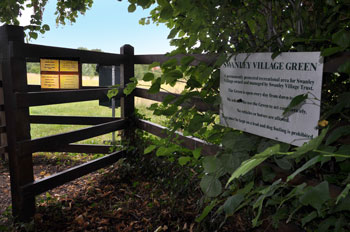Swanley Village in
Bloom
For up to date news see Newsletter Page
 |
 |
 |
|
Photography by Dennis Molyneux 01322 669523 |
Swanley Village in
Bloom
For up to date news see Newsletter Page
 |
 |
 |
|
Photography by Dennis Molyneux 01322 669523 |
Remember that if
the weather is very dry do not waste water on your lawn as it will survive
drought better than
any other part of the garden.
Many thanks to all who helped us this year - and we hope that we can be as successful in 2011.
We now show
a month by month guide of general gardening jobs
(perhaps for those inexperienced gardeners!) to help them plan their year in
their gardens.
Back to
Home Page
·
This is the month to get
all winter pruning done as it is a good job for cold, frosty weather.
·
Sort out tools and repair
any than need fixing.
·
Prune fruit trees
·
Plant climers if the
conditions in your garden soil allow
·
Start planning your
vegetable garden for the coming season
·
Lawns – a first cut can
often be made this month but only trim the very tops of the grass and always
collect it up
(for the compost heap)
·
Plant trees
·
Prune roses, buddleia,
clematis and autumn flowing shrubs.
·
Sow seeds under cover
·
Mulch
·
Mulch the bare ground
with a thick layer of organic material such as homemade garden or mushroom
compost.
Weed first, taking care
to remove all perennial weeds.
·
Weed now to get the worst
of your weeds cleared, it is then much easier to stay on top of them.
·
Turn the compost heap
using all made compost as mulch, especially in the vegetable garden.
·
Deadhead daffodils
·
Plant summer flowing
bulbs – lilies, dahlias, gladioli, alliums
·
Plants any herbaceous
perennials. Divide and replant any than have become too big or that you wish to
spread.
·
Plant new deciduous
shrubs.
·
Plant all climers and
prune all late-flowering (after end of June) clematis down to the lowest healthy
buds, removing last year’s
growth.
·
Spring clean lawns by
scratching them with a wire rake. Aerate with a fork – stick in deep.
·
Cut grass, mixing
clippings with straw for compost.
·
Start a regular sowing
regime of vegetables to ensure constant supply.
·
Weed
·
Plant evergreens.
·
Keep sowing hardy annuals
and prick out any that have been sown into seed trays last month.
Plant out sweet peas into
containers or open ground with support
·
Sow hardy vegetables.
·
April is a good month to
make a lawn and time spent preparing the ground is never wasted.
Continue cutting
established grass in dry weather, but no more than once a week.
·
The weeds will grow
faster this month than at any other time of the year. Weed a little every day
if you have the time.
·
With the warmer weather,
slugs and snails become more active. Go out with a torch and collect them up.
·
It is not too late to
start a garden from scratch – seize the moment!
·
Plant out tender bulbs
such as gladioli and dahlias.
·
Plant out tender annuals
such as sunflowers, nasturtiums and zinnias.
·
Sow biennials such as
wallflowers, foxgloves, forget-me-nots, or winter flowering pansies.
·
Prepare the soil so that
there are no clumps or stones
·
Prune early flowering
shrubs (such as forsythia) immediately after flowering.
·
Plant out tomatoes,
cucumbers and peppers into a greenhouse from the middle of the month.
·
Keep lawns mown once a
week, but leave as much grass to grow long as you can.
This will save time and money ,
will look lovely and will encourage beneficial insects and mammals to enjoy the
garden.
Just cut a simple path through
it.
·
Whenever the ground is
dry and no rain is forecast for a day, get out and hoe, even if it is only for a
few minutes.
This is the most effective and
easiest when the weeds are tiny.
·
Deadhead as much as you
can and sow and plant our tender annuals to maintain flowing through to autumn.
·
Clear away spring annuals
and biennials to make room for tender annuals.
·
Trim box hedges and
topiary.
·
Deadheading in general is
essential if you want to keep flowering going as long as possible.
·
Water young or newly
planted trees once a week.
·
Plant out tender annual
climers.
·
Keep tying up sweet peas
·
Plant out French beans,
sweetcorn, leeks.
·
Harvest strawberries,
raspberries, gooseberries, redcurrants, peas, broad beans, herbs and salad crop.
·
Sow carrots, lettuce and
chicory
·
Remember that if the
weather is very dry do not waste water on your lawn as it will survive drought
better than any other
part of the garden.
·
It is not too late to be
planting annuals nor to start a vegetable garden.
·
Water plants in
containers
·
Shade the greenhouse
·
Weed, especially with a
hoe, early in the morning, so that the cut weeds will die in the sun.
·
Lilies, gladioli and
chocolate cosmos are coming into flower and should be staked as necessary
·
Prune wisteria, climing
roses and jasmine.
·
Sweet peas are at their
very best and should be picked every ten days to maintain a supply of
good flowers for as long
as possible
·
Peas and beans should be
harvested regularly, and new potatoes should also be harvested now.
·
Remove side shoots from
tomato plants regularly
·
Lift and dry garlic as
soon as the foliage yellows
·
Do not mow lawns more
than once a week, leaving grass slightly longer if the weather is hot and dry.
Do not waste any water.
·
Weeds tend to have a new
lease of life in August so keep on top of them. At least stop perennial weeds
from setting seed
·
Keep deadheading
·
Pick fruit and collect
vegetables as they become ready.
·
Cut hedges
·
Buy spring flowering
bulbs and begin planting them from the middle of August.
·
Keep deadheading dahlias
and stake where necessary
·
As annuals finish
flowering lift and add to the compost heap.
·
The buddleia is at its
best in August and will attract butterflies.
·
Trim hedges
·
Harvest sweetcorn. Lift
onions and dry on a rack – the drier they are the better they will store.
·
Sow winter salad crops
such as lettuce, rocket, parsley, and spinach.
·
Sow grass seed or lay
turf. Have a tidy up of all scruffy and straggly areas, weed and generally get
the garden into shape.
·
Turn the compost heaps
ready to rot down over the winter and to make space for the end of summer
tidy-up.
·
Plant daffodilese, crocus
and scillas and other early spring bulbs – but not tulips.
·
Plant out biennials for
next year, such as forget-me-nots, wallflowers, sweet Williams and foxgloves.
·
Begin moving perennials
·
Deadheading is essential
for the late-flowering perennials
·
The tender plants will
continue as long as the weather is warm.
·
Evergreen trees and
shrubs can be planted or moved
·
Sow more winter salad
crops to be grown under cover
·
Lift maincrop potatoes
and store in a cool, dark place
·
This is the best month to
make a new lawn.
Prepare existing lawns
for winter by raking with a wire rake and aerating the soil with a fork.
·
Start digging and
preparing borders and beds – which will provide huge amounts of material for the
compost heap
for next year. The more ground
that is dug and manured the longer the soil will have to break down over the
winter.
·
Continue planting spring
bulbs but wait until November for tulips.
·
Plant deciduous trees.
·
Sow garlic and broad
beans.
·
Resist the temptation to
cut the lawn too short. Continue raking moss and aerating then brush on a
dressing of compost
and sharp sand into the holes
made by the aeration.
·
Plant deciduous trees,
hedges and shrubs.
·
Mark out and dig new
borders.
·
Plant tulips – as deep as
possible up to 15cm.
·
Plant grasses and
herbaceous perennials now.
·
Mow lawns weekly but only
if the ground is dry enough.
·
Sweep up all deciduous
leaves and collect them. If they are moist they will rot down by next spring.
to make excellent mulch
for woodland plants.
·
Scrub paths and patios
with diluted bleach to prevent slippery algae.
·
Protect tender plants
such as tree ferns or palms by covering them with straw or bracken, and wrapping
in Hessian or fleece.
·
Protect valuable pots and
statues from frost.
·
Finish planting tulips
·
Finish clearing borders
(if not already done)
·
Much of December’s work
is consolidating and trying to complete the things you began last month and
could not finish
through bad weather or lack of
time.
·
Keep sweeping leaves and
storing them. They are the best possible conditioner for the soil.
Burn all diseased leaves
and woody material. If at all possible, try to dig all new ground
by Christmas.
This gives the weather a
chance to break it up before you prepare it for cultivation in the Spring.
·
Make paths and patios as
time allows.